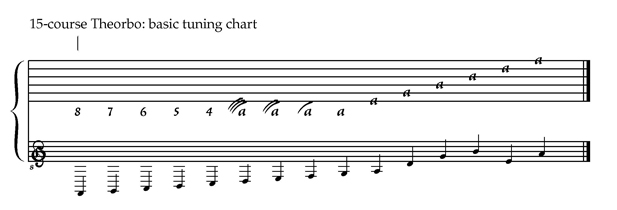



Theorbo
From Wikipedia, the free encyclopedia
 |
|
| Classification | |
|---|---|
| Related instruments | |
A theorbo (Italian: tiorba, also tuorbe; French: théorbe, Spanish: tiorba, German: Theorbe, Portuguese: teorba) is a plucked string instrument. As a name, theorbo signifies a number of long-necked lutes with second pegboxes, such as the liuto attiorbato, the French théorbe des pièces, the English theorbo, the archlute, the German baroque lute, the angélique or angelica. The etymology of the name tiorba
has not yet been explained sufficiently. It is hypothesized that its
origin might have been in the Slavic or Turkish "torba", meaning "bag"
or "turban". According to Athanasius Kircher, tiorba
was a nickname in the Neapolitan dialect that actually denoted the
grinding board used by perfumers for grinding essence and herbage.[1]
Contents |
Origin and development
Theorboes were developed during the late sixteenth century, inspired
by the demand for extended bass range for use in opera developed by the Florentine Camerata and new musical works based on basso continuo, such as Giulio Caccini's two collections, Le nuove musiche
(1602 and 1614). Musicians adapted bass lutes (c.80+ cm string length)
with a neck extension to accommodate open (i. e. unfretted) bass
strings, called diapasons or bourdons. The instrument was called both chitarrone and tiorba.
Although theorbo and chitarrone are virtually identical, they have
different etymological origins, chitarrone being a descendant of chitarra italiana (hence its name).
Similar adaptations to smaller lutes (c.55+ cm string length) produced the liuto attiorbato and the archlute, also similar-looking but differently tuned instruments.
In the performance of basso continuo, theorboes were often paired with a small pipe organ. The most prominent players and composers of the chitarrone in Italy were Giovanni Girolamo Kapsperger and Alessandro Piccinini. Little solo music for the theorbo survives from England, but William Lawes
and others used it in their chamber music, and it also appeared in
opera orchestras. In France, theorboes were appreciated and used in
orchestral music just as well as in chamber music, until the second half
of the 18th century (Nicolas Hotman, Robert de Visée). Court orchestras at Vienna, Bayreuth and Berlin employed theorbo players still after 1750 (Ernst Gottlieb Baron, Francesco Conti).
Solo music for the theorbo is notated in tablature.
Theorbo tuning
The tuning of large theorboes is characterized by the octave displacement, or reëntrant tuning, of the uppermost of the two uppermost strings. The courses,
unlike those of a Renaissance lute or archlute, were often single,
though double-stringing was used too. Typically, theorboes have 14
courses, though some used 15 or even 19 courses Kapsperger.
This is theorbo tuning
in A. Modern theorbo players usually play 14-course instruments, though
(lowest course is G). Some players have used a theorbo tuned a whole
step lower in G. All the solo repertoire is in the A tuning, the
Italians - Kapsperger, Castaldi, Piccinini, Viviani, Melli, Pittoni,
Bartolotti and French Visée, Hurel, de Moyne.
The reëntrant tuning created new possibilities for voice leading and inspired a new right technique with just thumb, index and middle fingers to arpeggiate chords, which Piccinini
likened to the sound of a harp. The bass tessitura and reëntrant
stringing mean that in order to keep the realisation above the bass when
accompanying Basso Continuo the bass must be sometimes played an octave lower Kapsperger.
In the French treatises chords in which a lower chord member sounds
after the bass were also used when the bass goes high. The English
theorbo had just the first string at the lower octave Thomas Mace.
Players
Notable living theorbists include Christopher Kendall (Folger Consort), Lynda Sayce, Pascal Monteilhet, Eduardo Egüez, Nigel North, Hopkinson Smith, Paul O'Dette, Andreas Martin, Rolf Lislevand, Christina Pluhar, Ugo Nastrucci, Jakob Lindberg, Robert MacKillop, Stephen Stubbs, Axel Wolf,[2] Mauricio Buraglia, and Jan Grüter, among others.
Literature
- Ekkehard Schulze-Kurz, Die Laute und ihre Stimmungen in der ersten Hälfte des 17. Jahrhundert, 1990, ISBN 3-927445-04-5, available at the author's homepage
- Robert Spencer, 'Chitarrone, Theorbo and Archlute', Early Music, Vol. 4 No. 4 (October 1976), 408-422, available at David van Edward's homepage.
- Diego Cantalupi, "La tiorba ed il suo uso in Italia come strumento per il basso continuo", pre-press version of the dissertation discussed in 1996 at the Faculty of Musicology, University of Pavia. Freely downloadable at Diego Cantalupi's homepage
See also
- Davide Rebuffa, Il liuto, L'Epos, Pelermo 2012.
References
- ^ Athanasius Kircher, Musurgia Universalis, Rome 1650, p. 476
- ^ "Zwischen Mars und Venus - Joel Frederiksen/ Ensemble Phoenix Munich - Projekt Martinelli, Sonntag, 25.04.2010 Bayerisches Nationalmuseum, Mars-Venus-Saal - München Ticket". Muenchenticket.de. 25 April 2010. Retrieved 7 March 2012.

